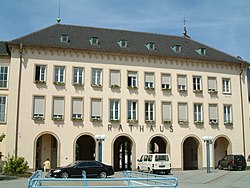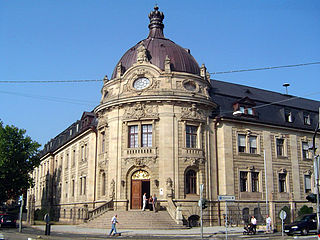
Landau, officially Landau in der Pfalz, is an autonomous (kreisfrei) town surrounded by the Südliche Weinstraße district of southern Rhineland-Palatinate, Germany. It is a university town, a long-standing cultural centre, and a market and shopping town, surrounded by vineyards and wine-growing villages of the Palatinate wine region. Landau lies east of the Palatinate forest, on the German Wine Route.

The Palatinate, or the Rhenish Palatinate (Rheinpfalz), is a historical region of Germany. Palatinate occupies most of the southern quarter of the German federal state of Rhineland-Palatinate (Rheinland-Pfalz), covering an area of 2,105 square miles (5,450 km2) with about 1.4 million inhabitants. Its residents are known as Palatines (Pfälzer).

Zweibrücken is a town in Rhineland-Palatinate, Germany, on the Schwarzbach river.

Simmern is a town of roughly 7,600 inhabitants (2013) in Rhineland-Palatinate, Germany, the district seat of the Rhein-Hunsrück-Kreis, and the seat of the Verbandsgemeinde Simmern-Rheinböllen. In the Rhineland-Palatinate state development plan, it is set out as a middle centre.

Neustadt an der Weinstraße is a town in Rhineland-Palatinate, Germany. With 53,300 inhabitants as of 2020, it is the largest town called Neustadt.

Bad Dürkheim is a spa town in the Rhine-Neckar urban agglomeration. It is the seat of the Bad Dürkheim district in Rhineland-Palatinate, Germany, and the site of the discovery of the element caesium, in 1860.

Annweiler am Trifels, or Annweiler is a town in the Südliche Weinstraße district, in Rhineland-Palatinate, Germany. It is situated on the river Queich, 12 km west of Landau. Annweiler am Trifels station is on the Landau–Saarbrücken railway.

Wachenheim an der Weinstraße is a small town in the Bad Dürkheim district in Rhineland-Palatinate, Germany, roughly 1 km south of Bad Dürkheim and 20 km west of Ludwigshafen. It is known above all else for its various businesses in the field of winegrowing, and in particular for Sekt.
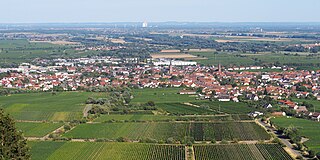
Edenkoben is a municipality in the Südliche Weinstraße district, in Rhineland-Palatinate, Germany. It lies approximately halfway between Landau and Neustadt an der Weinstraße. Edenkoben is one of the towns situated along the German Wine Route. Edenkoben is the seat of the Verbandsgemeinde Edenkoben.
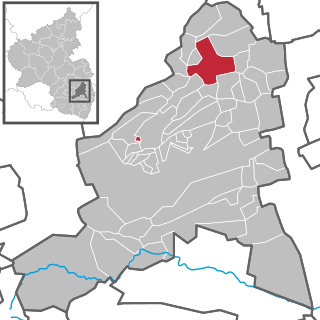
Grünstadt is a town in the Bad Dürkheim district in Rhineland-Palatinate, Germany with roughly 13,200 inhabitants. It does not belong to any Verbandsgemeinde – a kind of collective municipality – but is nonetheless the administrative seat of the Verbandsgemeinde of Leiningerland.
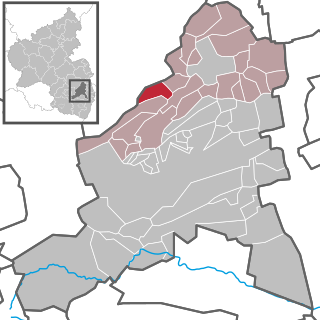
Hettenleidelheim is an Ortsgemeinde – a municipality belonging to a Verbandsgemeinde, a kind of collective municipality – in the Bad Dürkheim district in Rhineland-Palatinate, Germany. Until 2018, it was the seat of the like-named Verbandsgemeinde.

Hochspeyer is a municipality in the district of Kaiserslautern, in Rhineland-Palatinate, Germany. It is situated in the Palatinate forest, approx. 10 km east of Kaiserslautern.

Bockenheim an der Weinstraße is an Ortsgemeinde – a municipality belonging to a Verbandsgemeinde, a kind of collective municipality – in the Bad Dürkheim district in Rhineland-Palatinate, Germany.

Ebertsheim is an Ortsgemeinde – a municipality belonging to a Verbandsgemeinde, a kind of collective municipality – in the Bad Dürkheim district in Rhineland-Palatinate, Germany.

Kindenheim is an Ortsgemeinde – a municipality belonging to a Verbandsgemeinde, a kind of collective municipality – in the Bad Dürkheim district in Rhineland-Palatinate, Germany.

Laumersheim is an Ortsgemeinde – a municipality in the Bad Dürkheim district in Rhineland-Palatinate, Germany. It lies in the northwest part of the Rhine-Neckar urban agglomeration.
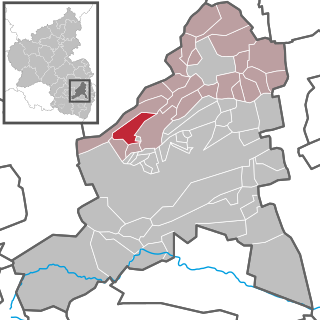
Carlsberg is an Ortsgemeinde – a municipality belonging to a Verbandsgemeinde, a kind of collective municipality – in the Bad Dürkheim district in Rhineland-Palatinate, Germany.
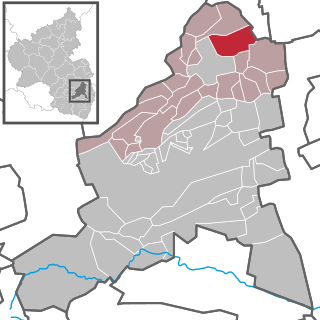
Obrigheim (Pfalz) is an Ortsgemeinde – a municipality belonging to a Verbandsgemeinde, a kind of collective municipality – in the Bad Dürkheim district in Rhineland-Palatinate, Germany. It lies in the northwest of the Rhine-Neckar urban agglomeration.
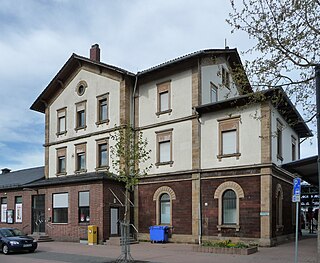
Grünstadt station is a railway junction where the Palatine Northern Railway connects with the Eis Valley Railway and the disused tracks of the Leiningen Valley Railway and the Worms–Grünstadt railway. It is one of three stations in the urban area of Grünstadt in the German state of Rhineland-Palatinate. The station's entrance building of 1873 as well as parts of the premises are protected as monuments. It is classified by Deutsche Bahn as a category 4 station.

The Palatine Higher Regional Court in Zweibrücken is one of two Higher Regional Courts in the German state of Rhineland-Palatinate, along with the Higher Regional Court in Koblenz.
